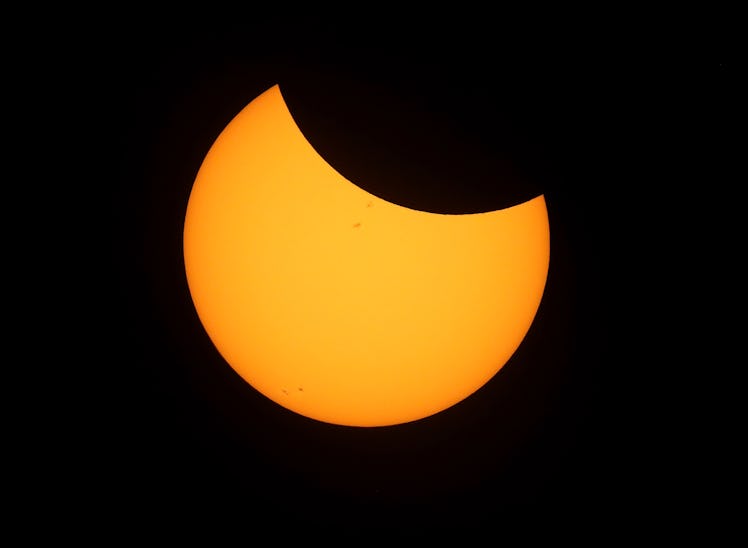
A Partial Solar Eclipse Is Coming & Here's What You Need To Know About Seeing It
I know you're still coming away from the colossal fusion of eclipse activity that was the super blue blood moon on Jan. 31 but don't get too comfortable yet — just when you thought you could turn your astronomical fascination down to a simmer, the universe is deciding to book an upcoming partial solar eclipse in the sky on Feb. 15. I'm sure you remember the blazing excitement that took over the world during the Aug. 21, 2017 total solar eclipse. However, if you're thinking that Feb. 15 will be more of the same, think again. We've got a major difference between the two eclipses — namely that last year's eclipse was "total" while this year's is only "partial." Have you got a million questions already? I know I do. For starters, can you see a partial solar eclipse? To give you a quick answer: maybe.
Before we get into more detail about that, let's talk about what distinguishing characteristics actually define a partial solar eclipse. All solar eclipses occur during the new moon phase of the lunar cycle and the effect of a dark shadow obscuring our sun is the result of the moon slipping in-between the Earth and the sun during her orbit around our home planet. In the case of our solar eclipse on Feb. 15, the three celestial bodies won't be aligned in a perfectly straight line, causing the Sun to be only partially eclipsed by the moon's shadow. From our perspective, it'll look like a round slice has been cut from the Sun, rather than the sun being blanketed by a shadow completely (as would be the case for a total solar eclipse).
The reason you might not be able to see this dramatic solar event is because it will only be visible from South American countries such as Argentina, Chile, Uruguay, Paraguay, and Brazil. If you happen to be in Antarctica or perhaps, maybe even in the middle of the South Pacific Ocean, you'll also be able to sneak a glimpse at the partial solar eclipse.
However, don't jump for joy just yet if you'll be in any of those places on Feb. 15. According to TIME, you might not even be able to notice the eclipse take place. Unlike the total solar eclipse on Aug. 21 that conspicuously dimmed our sunny summer afternoon, there probably won't be any observable darkness shrouding the world.
On the other hand, Eclipse Wise specifies that this partial solar eclipse will be a very deep one, meaning that it won't be as minor as a tiny shadow grazing against the edge of the sun. Instead, the eclipse will take a pretty significant chunk out of it. Another important thing to note is that the depth of the eclipse will appear more apparent the father south you are located. In fact, the best place to view the eclipse is in Antarctica.
The two biggest cities that fall in the path of this eclipse are Montevideo and Buenos Aires. They will be able to catch the tail end of this solar event starting at 6:37 PM, reaching maximum eclipse at 7:13 P.M.
If you just so happen to be lucky enough to be in South America on Feb. 15, make sure you take proper safety precautions to protect your eyes when looking at the solar eclipse. As I'm sure you remember everyone donning solar goggles during last year's total solar eclipse, this solar phenomena is no different. Normal sunglasses, no matter how strong their UV-protection, will not suffice. The most foolproof way to view the eclipse is through a pin-hole camera, which you can easily make at home with some card stock, tape, aluminum foil, and a paper clip! NASA has included DIY instructions here.
Regardless of how you choose to observe the Feb. 15 partial solar eclipse, remember never to look at it directly with your eyes, as this can result in serious injury.